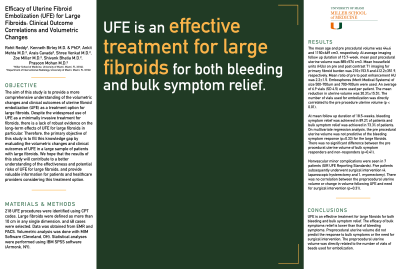Back

Women’s Health
110 - Efficacy of Uterine Fibroid Embolization (UFE) for Large Fibroids: Clinical Outcome Correlations and Volumetric Changes

Kenneth Briley, MD, PhD – Fellow, Interventional Radiology, University of Miami; Ankit Mehta, MD – Fellow, Interventional Radiology, University of Miami; Arais Cavada, MSN – Nurse Practitioner, Interventional Radiology, University of Miami; Shree Venkat, MD – Associate Professor, Interventional Radiology, University of Miami; Zoe Miller, MD – Associate Professor, Interventional Radiology, University of MIami; Shivank Bhatia, MD – Professor & Chair, Interventional Radiology, Univeristy of Miami; Prasoon Mohan, MD – Associate Professor, Interventional Radiology, University of Miami
Purpose: Existing literature on the outcomes of UFE for large fibroids is limited. The aim of this study is to evaluate the volumetric changes and clinical outcomes following UFE for large fibroids.
Material and Methods: 218 UFE procedures were identified using CPT codes. Large fibroids were defined as more than 10 cm in any single dimension, and 48 cases were selected. Data was obtained from EMR and PACS. Volumetric analysis was done with MIM Software (Cleveland, OH). Statistical analyses were performed using IBM SPSS software (Armonk, NY).
Results: The mean age and pre procedural volume was 44±6 and 1150±669 cm3, respectively. At average imaging follow up duration of 15.7-week, mean post procedural uterine volume was 885±576 cm3. Mean housefield units (HUs) on pre and post contrast T1 imaging for primary fibroid burden was 210±153.5 and 412.2±351.9, respectively. Mean ratio of pre to post enhancement HU was 2.2±1.5. Embospheres (Merit Medical Systems) of size 500-700um and 700-900um were used. An average of 6.9 vials (SD 4.5) were used per patient. The mean reduction in uterine volume was 30.3%±15.5%. The number of vials used for embolization was directly correlated to the pre procedure uterine volume (p < 0.01).
At mean follow up duration of 18.5-weeks, bleeding symptom relief was achieved in 89.2% of patients and bulk symptom relief was achieved in 73.3% of patients. On multivariate regression analysis, the pre procedural uterine volume was not predictive of the bleeding symptom response (p=0.33) for the large fibroids. There was no significant difference between the pre procedural uterine volume of bulk symptom responders and non-responders (p=0.41).
Nonvascular minor complications were seen in 7 patients (SIR UFE Reporting Standards). Five patients subsequently underwent surgical intervention (4, laparoscopic hysterectomy and 1, myomectomy). There was no correlation between the preprocedural uterine volume or change in volume following UFE and need for surgical intervention (p=0.31).
Conclusions: UFE is an effective treatment for large fibroids for both bleeding and bulk symptom relief. The efficacy of bulk symptoms relief is lower than that of bleeding symptoms. Preprocedural uterine volume did not predict the response to bulk symptoms or the need for surgical intervention. The preprocedural uterine volume was directly related to the number of vials of beads used for embolization.
Material and Methods: 218 UFE procedures were identified using CPT codes. Large fibroids were defined as more than 10 cm in any single dimension, and 48 cases were selected. Data was obtained from EMR and PACS. Volumetric analysis was done with MIM Software (Cleveland, OH). Statistical analyses were performed using IBM SPSS software (Armonk, NY).
Results: The mean age and pre procedural volume was 44±6 and 1150±669 cm3, respectively. At average imaging follow up duration of 15.7-week, mean post procedural uterine volume was 885±576 cm3. Mean housefield units (HUs) on pre and post contrast T1 imaging for primary fibroid burden was 210±153.5 and 412.2±351.9, respectively. Mean ratio of pre to post enhancement HU was 2.2±1.5. Embospheres (Merit Medical Systems) of size 500-700um and 700-900um were used. An average of 6.9 vials (SD 4.5) were used per patient. The mean reduction in uterine volume was 30.3%±15.5%. The number of vials used for embolization was directly correlated to the pre procedure uterine volume (p < 0.01).
At mean follow up duration of 18.5-weeks, bleeding symptom relief was achieved in 89.2% of patients and bulk symptom relief was achieved in 73.3% of patients. On multivariate regression analysis, the pre procedural uterine volume was not predictive of the bleeding symptom response (p=0.33) for the large fibroids. There was no significant difference between the pre procedural uterine volume of bulk symptom responders and non-responders (p=0.41).
Nonvascular minor complications were seen in 7 patients (SIR UFE Reporting Standards). Five patients subsequently underwent surgical intervention (4, laparoscopic hysterectomy and 1, myomectomy). There was no correlation between the preprocedural uterine volume or change in volume following UFE and need for surgical intervention (p=0.31).
Conclusions: UFE is an effective treatment for large fibroids for both bleeding and bulk symptom relief. The efficacy of bulk symptoms relief is lower than that of bleeding symptoms. Preprocedural uterine volume did not predict the response to bulk symptoms or the need for surgical intervention. The preprocedural uterine volume was directly related to the number of vials of beads used for embolization.
